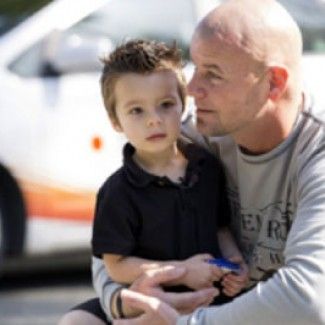Dad’s Pediatric CPR training saves his child from being a statistic

Thanks to Lori Pena, safety coordinator and MEDIC First Aid instructor with the Sacramento Municipal Utility District (SMUD) for sharing SMUD lineman Dwight Johnson’s story with us.
From SMUD’s inter-office news:
Dwight Johnson credits cardiopulmonary resuscitation training at SMUD for helping save his two-year-old son Mason (shown at right with dad Dwight) last month when the toddler fell into their backyard pool.
Mason was at the bottom of the pool for two to three minutes before his father found him, jumped in, pulled him out of the pool and immediately started CPR as his wife Crystal called 911.
The incident occurred March 13, and Mason spent 29 days in the hospital, including seven days in an intensive care unit. He was in a coma the first four days in the ICU because of severe swelling of the brain.
“On the fifth day he opened his eyes,” Johnson recalled. “The doctors were amazed he did that. They honestly weren’t sure he was going to make it.” Little Mason returned to his Fair Oaks home from the hospital on April 10. His speech and movements are a little slow, Johnson said, but he’s running around and playing like any two-year-old. “He’s the toughest guy I know,” Johnson said as he watched Mason play with his older siblings Eric, 12, Lauren, 8, and Ryan, 6. “I wish I had the will to live that he has.”
Johnson recalls that the morning of March 13 started as usual, the three older kids were off to school, leaving him, Crystal, and Mason to enjoy some quiet time. Mason was eating his breakfast in the living room while his parents were in the kitchen. “I went to the living room to see what he was doing, but I didn’t see him,” Johnson said. “So I ran to his bedroom and he wasn’t there either. I knew immediately that he was probably in the backyard.”
Johnson sprinted to one of the usually closed sliding glass doors that lead to their backyard, which includes a pool. One of the sliding glass doors was slightly open – enough space for a two-year-old to slip through. The Johnsons had moved into their Fair Oaks home about a month before and were in the process of getting a fence built around the pool. A previous homeowner had taken it out.
“As soon as I got to the slider [door], I saw him at the bottom of the pool,” Johnson said. After getting Mason out of the pool, Johnson started performing CPR. “I did about four to five sets of CPR until the paramedics arrived,” he said. “I was doing CPR until they pulled him out of my arms and took him to the hospital.”
It was his CPR training at SMUD and eight years as an Army medic that kept Johnson calm and focused during such a horrific moment. “It’s amazing training,” Johnson said of SMUD’s CPR training. Instincts honed from the training took over at that moment. “I didn’t even hesitate to start CPR,” he recalled. “It was almost like a hurt man rescue training [for line workers].”
Line workers, troubleshooters, substation electricians, and other employees who usually work in the field are required to take training classes on CPR, first aid, and the use of the automatic external defibrillators that are stored in line trucks for medical emergencies, said Grid Assets safety coordinator Lori Pena. “It’s a regulatory requirement.”
And it makes good safety sense. A lot of the field forces often work in remote areas where immediate medical attention is not available. In addition, because a lot of them have young children, they asked that the training include a section on infant and child CPR, Pena said. SMUD obliged and added that component to its training several years ago. In the case of the Johnson family, that training was literally a life-saver.
“It’s awesome that the training helped save a child’s life,” Pena said. “The training did exactly what it was intended to do. It fulfilled its purpose.”
Clearly, SMUD has an outstanding safety culture. They even open up their CPR training to their office and professional staff, to ensure that lifesaving skills are available by trained responders throughout the SMUD employee community.
If your organization offers emergency care training, have you considered adding a pediatric component? ASHI instructors can incorporate the child and infant training sections into their regular CPR and AED classes, while our MEDIC First Aid instructors can add the Child/Infant CPR and AED Supplement program to round out theirBasicPlus offerings. Adding these skills to your students’ training sessions helps them prepare to respond to anyone in need.
Looking to take a class yourself? Check us out to get started, and thank you for taking that first step in making protecting and saving lives easy.

